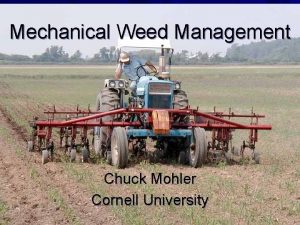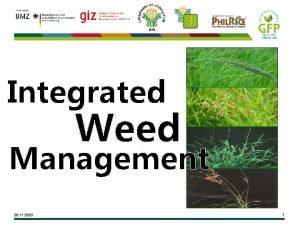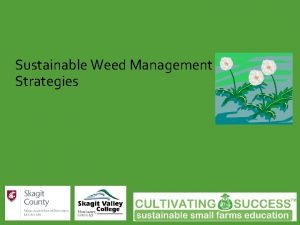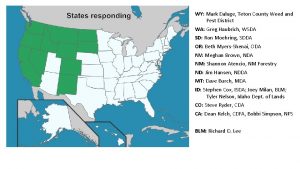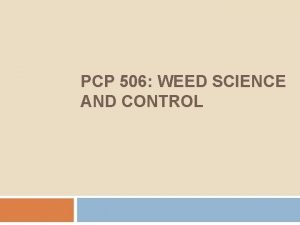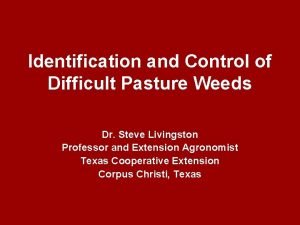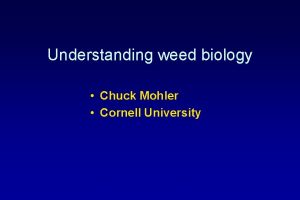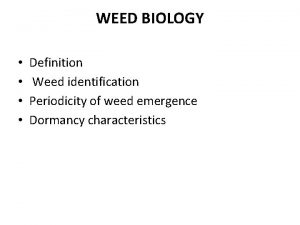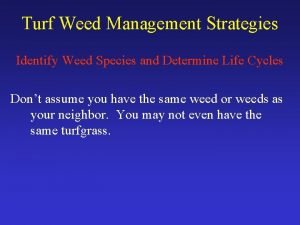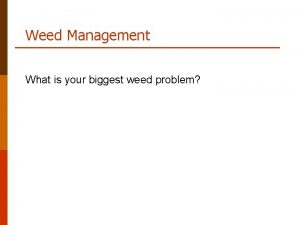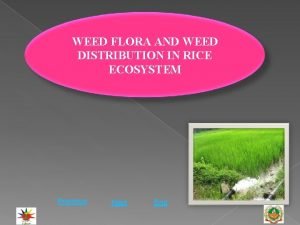Using weed ecology for management Chuck Mohler Cornell



















- Slides: 19

Using weed ecology for management Chuck Mohler Cornell University

Outline • Intro – “Many little hammers” • Causes of weed mortality through the life cycle • Thoughts on fertility • Crop rotation and weed management • Preventive weed management • How to use the manual • Discussion

Many little hammers

Any little hammer

Integration • • • Crop rotation Crop competitiveness Type and timing of tillage & cultivation Water and nutrient management Mulches

Causes of mortality through the life cycle

Crop rotation: two considerations 1. Vary the seasonality of planting -– Tillage for spring crops kills off winter annuals like annual bluegrass and shepherd’s purse – Tillage for summer crops kills off spring germinating weeds like ragweed. – Fall crops allow time for a midsummer fallow to fight purslane.

Crop rotation: two considerations 2. Varying crops allows you to vary management practices – Can tine weed corn, peas, snap beans – Can cultivate root crops very close to the row – Hill up potato and corn to kill in-row weeds – Flame weed corn & alliums – Straw mulch garlic – Short season crops like lettuce do not allow seed production – act like a fallow period

Varying crop seasonality and management practices prevent any one species from getting out of control Use short season crops like lettuce and spinach Or easily weeded and competitive crops like potato To clean up after crops like winter squash where weeds often go to seed

Over fertilization • Many weed species are highly responsive to soil fertility. • Weeds often have 1. 5 to 3 X higher N, P, K, & Ca concentrations than the crops they are growing with. • Excess fertility increases weed growth rates.

Experiment at Martens’ Farm • Applied 0, 0. 6, 1. 5, 3, or 6 ton/A of compost. • Either a high N, high solubility compost, or a more digested stable compost. • On the graphs “soluble” is about 5 - 2 • “organic” is about 1. 4 - 3. 6 - 1. 5

Response of corn yield to fertility

Weed response to fertility

Two basic approaches to organic weed management

Standard management • reduce weed populations below level at which they cause noticeable yield loss • Weed populations vary greatly between years • Yield loss is hyperbolic— no threshold – Wild oat in wheat

Preventive management • • Don’t let weeds reproduce Requires constant vigilance Extra management in early years Fallows, hand rogueing

Prevention—management costs

Prevention—yield loss

How to use “The Growers Handbook to Ecological Weed Management” • Understand the general biology of various types of weeds • Understand the general principals of ecological weed management • Identify the critical weed problems on the farm • Read about the specific biology of the problem weeds • Devise a management plan that exploits the weaknesses in the species’ biology.
 Chuck mohler cornell
Chuck mohler cornell Buddingh basket weeder
Buddingh basket weeder Cristina möhler
Cristina möhler Shawn midlam-mohler
Shawn midlam-mohler Disadvantages of integrated weed management
Disadvantages of integrated weed management Sustainable weed management
Sustainable weed management Management by chuck williams
Management by chuck williams Cockroach control teton county
Cockroach control teton county Jewel weed medicinal
Jewel weed medicinal The thallus of a macroalgae refers to its:
The thallus of a macroalgae refers to its: Edaphic factors affecting crop production
Edaphic factors affecting crop production Mia's growing like a weed answers
Mia's growing like a weed answers Weed science definition
Weed science definition Sniffable weed
Sniffable weed Smutgrass identification
Smutgrass identification Weed control murphy
Weed control murphy Accident weed diagram
Accident weed diagram Brain parts
Brain parts Coco chanel less is more
Coco chanel less is more Dumbi sitti weed
Dumbi sitti weed

